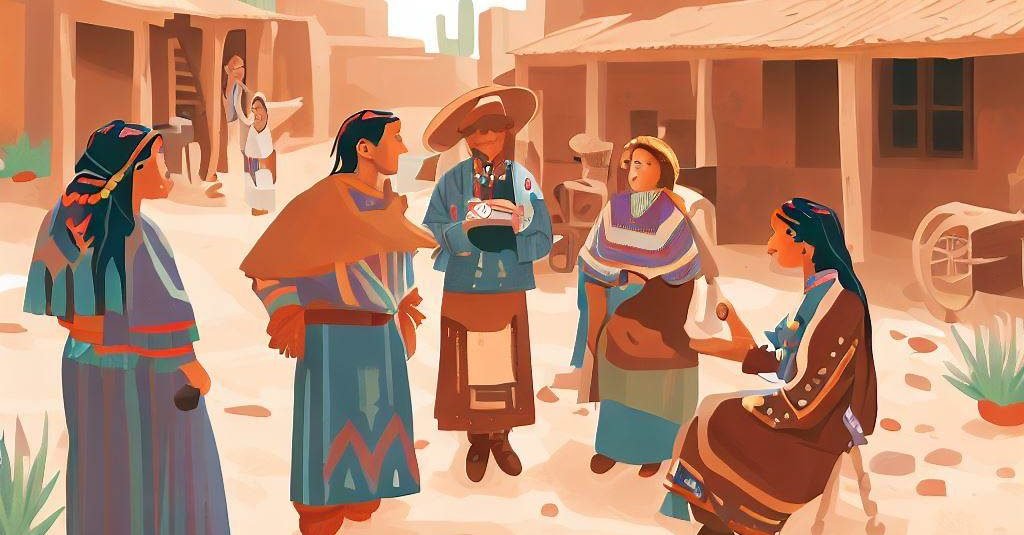The Diné Language: A Comprehensive Exploration of the Linguistic Heritage of the Navajo People
Introduction
The Diné language, also known as Navajo, is a prominent indigenous language spoken by the Navajo people in the southwestern United States. As a key member of the Athabaskan language family, Diné boasts a rich linguistic and cultural heritage that has played an essential role in shaping the Navajo people’s history and identity. This article aims to provide an in-depth examination of the Diné language, its features, development, and connections with other Native American languages and cultures.
Historical Background
The Diné language is primarily spoken within the Navajo Nation, a vast area encompassing parts of Arizona, New Mexico, and Utah. As a Southern Athabaskan language, Diné shares common origins with other Athabaskan languages spoken in the western parts of North America, such as Apache and Gwich’in. Linguists believe that the Athabaskan languages, including Diné, began to diverge from their common ancestor around 1,500 years ago as a result of various tribal migrations and cultural interactions.
Phonology
The Diné language has a complex phonological system that distinguishes it from many other Native American languages. It features a large consonant inventory, including lateral fricatives, ejective stops, and glottalized sonorants. Vowels, on the other hand, are characterized by a system of four basic vowels, each with distinct oral and nasal forms. Vowel length and tone are also essential features, with high, low, rising, and falling tones used to differentiate between words and convey meaning.
Morphology and Syntax
Diné is a polysynthetic language, which means that it employs multiple affixes to express complex meanings within a single word. This results in long, morphologically complex words that can often be translated into entire sentences in English. Verbs are central to the language, with an extensive system of prefixes and suffixes used to convey various grammatical features, such as tense, aspect, mood, and subject-object relationships.
The syntax of Diné is characterized by a flexible word order, with a general preference for subject-object-verb (SOV) structures. However, variations in word order are possible, and the focus can often be shifted to highlight specific elements within a sentence. Another distinctive feature of Diné syntax is the use of postpositions instead of prepositions, which is a common trait among other Athabaskan languages.
Connections with Other Native American Languages and Cultures
The linguistic features of the Diné language reveal connections with other Native American languages and cultures, particularly those belonging to the Athabaskan language family. For example, the complex verb morphology and polysynthetic nature of Diné are shared with many other Athabaskan languages, such as those spoken by the Apache tribes. Additionally, similarities in phonological systems, syntax, and vocabulary provide further evidence of a shared linguistic heritage among the Athabaskan languages.
Furthermore, the Diné language exhibits connections with other non-Athabaskan Native American languages and cultures. For instance, the use of tone to convey meaning in Diné is a feature shared with several other indigenous languages, such as the Muskogean language family spoken in the southeastern United States. Similarly, the presence of a rich system of classifiers, which help categorize and provide additional information about nouns, is a feature found in both Diné and many other Native American languages, such as those belonging to the Chimakuan and Muskogean language families. These shared linguistic features highlight the interconnected histories and cultural experiences of Native American peoples across the continent.
Language Revitalization and Preservation
Like many other indigenous languages, Diné has experienced a decline in the number of speakers over the past century, primarily due to the influence of colonization, forced assimilation, and the widespread use of English. However, recent years have seen a resurgence of interest in preserving and revitalizing the Diné language. Efforts by the Navajo Nation, educational institutions, and language activists have focused on documentation, development of learning materials, and promotion of language use among younger generations.
Some of these revitalization efforts include bilingual education programs in schools within the Navajo Nation, language immersion camps, and community-based workshops. Additionally, the development of digital resources, such as mobile apps and online dictionaries, has facilitated access to the Diné language for learners and speakers alike. Through ongoing collaboration and support, these initiatives aim to ensure the survival and growth of the Diné language as an essential aspect of Navajo cultural heritage.
Conclusion
The Diné language, as a central component of the Navajo people’s identity, embodies a rich linguistic and cultural heritage that is intertwined with the histories, cultures, and experiences of other Native American peoples. By exploring the language’s unique features, development, and connections with other indigenous languages, we can foster a greater understanding of the diverse and interconnected tapestry of Native American linguistic traditions.
Through continued efforts to preserve and revitalize the Diné language, the Navajo people and their allies contribute to a broader movement to recognize and celebrate the invaluable linguistic and cultural legacy of indigenous communities across North America. These initiatives serve as a testament to the resilience, unity, and enduring importance of Native American languages and cultures, both today and for generations to come.
Sources Consulted
- Campbell, L. (1997). “American Indian languages: The historical linguistics of Native America”. Oxford University Press.
- Fernald, T. B., & Platero, P. R. (2015). “The Athabaskan languages: Perspectives on a Native American language family”. Oxford University Press.
- Gippert, J., Himmelmann, N. P., & Mosel, U. (Eds.). (2006). “Essentials of language documentation”. Walter de Gruyter.
- Golla, V. (2011). “California Indian languages”. University of California Press.
- Hinton, L., & Hale, K. (Eds.). (2001). “The green book of language revitalization in practice”. Academic Press.
- Martin, J. (2011). “A grammar of Creek (Muskogee)”. University of Nebraska Press.
- McDonough, J. M. (2003). “The Navajo sound system”. John Benjamins Publishing.
- Mithun, M. (1999). “The languages of Native North America”. Cambridge University Press.
- Reyhner, J., & Lockard, L. (Eds.). (2009). “Indigenous language revitalization: Encouragement, guidance & lessons learned”. Northern Arizona University.
- Young, R. W., & Morgan, W. (1987). “The Navajo language: A grammar and colloquial dictionary”. University of New Mexico Press.

